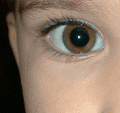|
Digital Camera Chronicles
24 -- It was a bright, sunny morning...
(Jun 2002)
(by Conrad H. Blickenstorfer)
 It was a bright, sunny Sunday morning a couple of years ago. My then five-year-old son and I were horsing around in the pool, having a grand old time, and my wife wanted to take pictures. I gave her my digital camera and resumed playing with my son who had a ball with his new rubber raft. After we were done and dried off I wanted to take a look at the pictures on the camera's LCD. My wife said she had only taken about a dozen pictures because it was difficult to see anything on the LCD, and besides, she couldn't hear the shutter and therefore didn't really know when the camera took a picture. It turns out she had taken not a dozen but a total of 63 pictures. She didn't know that because the camera had not given her any feedback that told her when a picture was taken. She also said she never felt the camera took a picture when she pushed the shutter button. I was happy with the 63 pictures because though they had pretty much been taken automatically almost all were in focus. Still, I was concerned about my wife's feedback and experience, as the same had happened to me. I hoped that the digital camera industry would quickly address those two glaring problems: shutter lag and the lack of feedback, and the fact that the LCD becomes useless in sunlight.
It was a bright, sunny Sunday morning a couple of years ago. My then five-year-old son and I were horsing around in the pool, having a grand old time, and my wife wanted to take pictures. I gave her my digital camera and resumed playing with my son who had a ball with his new rubber raft. After we were done and dried off I wanted to take a look at the pictures on the camera's LCD. My wife said she had only taken about a dozen pictures because it was difficult to see anything on the LCD, and besides, she couldn't hear the shutter and therefore didn't really know when the camera took a picture. It turns out she had taken not a dozen but a total of 63 pictures. She didn't know that because the camera had not given her any feedback that told her when a picture was taken. She also said she never felt the camera took a picture when she pushed the shutter button. I was happy with the 63 pictures because though they had pretty much been taken automatically almost all were in focus. Still, I was concerned about my wife's feedback and experience, as the same had happened to me. I hoped that the digital camera industry would quickly address those two glaring problems: shutter lag and the lack of feedback, and the fact that the LCD becomes useless in sunlight.
It's two years later, and little has changed.
A while ago I spent time with the Nikon Coolpix C5000--a high-end prosumer camera that goes for around US$1,000--and wrote a review that ran in the last issue of Digital Camera. I liked the five megapixel resolution but found the camera unresponsive and the LCD as unreadable outdoors as ever. Once again, I never really knew whether I had taken a picture or not, and it seemed to take a long time for the camera to react after I pressed the shutter. It's conceivable that the C5000 did give me some feedback when it took a picture, but it certainly wasn't anything like the good old-fashioned shutter click of a conventional camera. Even when I used the flash and thus knew when the picture was taken, it seemed like it took a long time between me pressing the shutter button and the camera actually taking the picture. Well, perhaps not a "long time" but 1.06 seconds, according to the Imaging-Resource.com photo equipment review website, which measured the shutter lag of a number of the more popular digital cameras. A lot can happen in a second, and it is an eternity in a field where shutter speeds are measured in thousandths of a second. While the C5000's shutter lag is long even compared to its competition (many of its competitors are in the 0.6 to 0.8 second range), all digital cameras experience shutter lag. That's because after you press the shutter button, the camera must set the focus, compute exposure, white balance and a variety of other settings. The image is captured only after all of that is done, and as a result you may or may not have the picture you wanted to take. Not a good situation. And one that is exacerbated by the fact that you then need to wait for the image to be written to storage before you can take another shot. There are some workarounds in modern digital cameras, such as the ability to record several frames with one shutter click, but that does not really address the basic problem of shutter lag. There must be a reasonable compromise that allows the camera to do its computations and assures the photographer that the shutter goes off when it is pressed.
I also noticed that the C5000's tiny 1.8-inch LCD was just as unreadable outdoors as that of almost any other digital camera I've ever used. That's because it uses standard TFT technology, which delivers great viewing indoors but becomes unreadable in direct sunlight. We've often asked industry representatives why they don't simply switch to a different display technology. They do exist. Reflective LCDs, for example, are brightest and most readable in direct sunlight (though not very readable indoors where there is less light to reflect) and transflective displays where some light is reflected (good for outdoor readability) and some light is transmitted through the display (good for indoor readability). Now, while it is nice to have a bright LCD for indoor use, I really want one that I can use outdoors. The reason given why such display technologies are not used in digital cameras is cost. I find that hard to believe because another industry that struggled with the same problem has quickly made the change: PDAs didn't really become successful until they switched to reflective color displays. Casio, for example, had a number of PDAs with bright TFT displays that received very positive feedback. Unfortunately, they were not readable outdoors. When Compaq introduced the iPAQ PDA, it had a reflective screen so that people could use the device outdoors. Indoors, a sidelight provided adequate readability. The iPAQ was a success and today all new Pocket PCs have reflective color displays. If PDA manufacturers were able to absorb the cost of a reflective display that is much larger than that in a digital camera costing twice as much, why won't camera manufacturers do it? Especially since cameras are actually more likely to be used outdoors than PDAs.
So, camera manufacturers, here's the deal: Since I have Adobe Photoshop (and a slew of those easy-to-use image correction programs that come with every digicam) I am willing to do with a bit less computation inside the camera even if it means the picture is slightly less perfect and I have to tweak things every now and then. And although PDA vendors have proven that reflective displays do not have to result in price increases, I am willing to pay a bit more for a display that I can see outdoors as well as indoors.
Do we have a deal?
|








